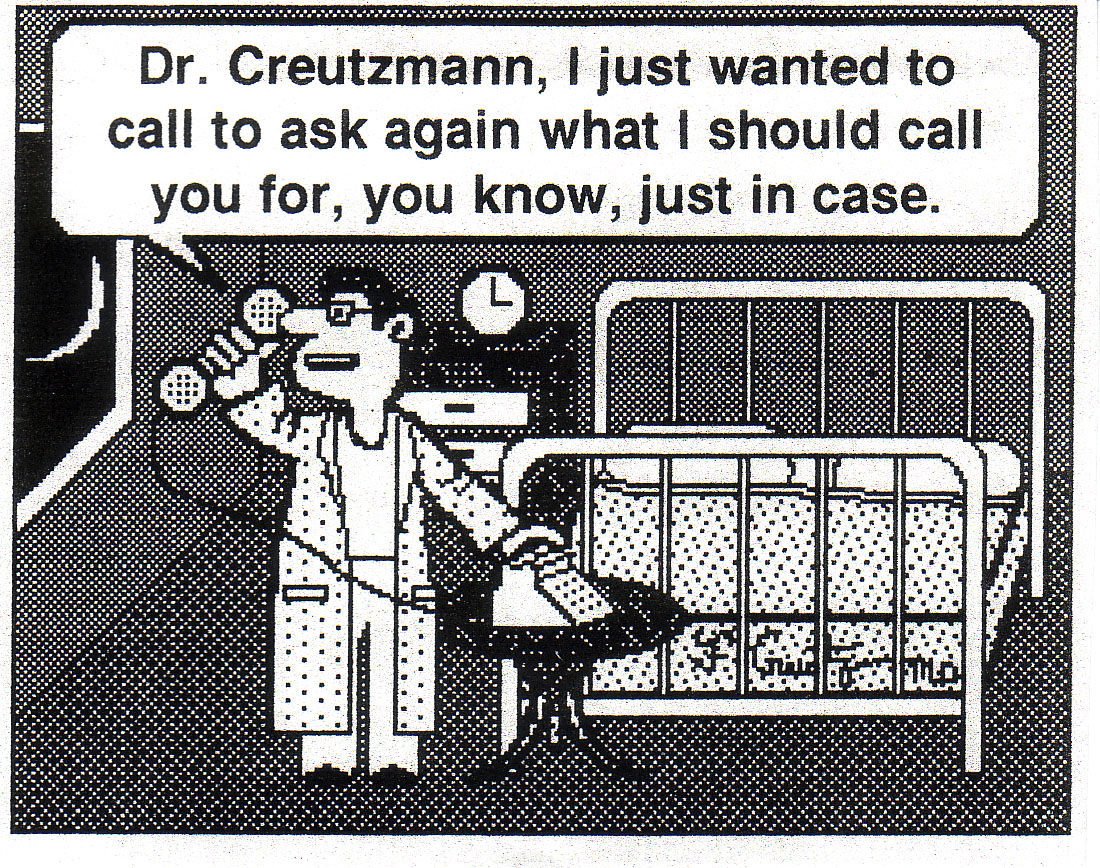
False Labor Vs. Actual Labor;
When Should You Contact Your Physician?
Doctor Creutzmann, when should I call you? Well, the answer to that takes some explaining. Of course, you should call if you are concerned about something, that's why I'm here. The "Big Three" reasons to call are:
1) The onset of labor. Usually contractions every 5-6 minutes is a
good rule of thumb.
2) Bleeding. That is flowing bleeding, like a period. A bloody mucus discharge is not a reason for concern. See below.
3) The breaking of the water. If you are not sure if you should or shouldn't call, you probably should.
As you approach childbirth, you will become aware of tightenings in your uterus, but felt more in your abdomen and groin. These are Braxton-Hicks contractions, which are not true labor. Some women experience these false labor contractions up to five months before the actual delivery, but are not usually present until the seventh or eighth month. There are a few ways to tell the difference between true and false labor, but sometimes the dividing line is very hard to draw. Usually, way to differentiate between the two is to consider the frequency of the contractions, the intensity and the location of the pain. Should the cramping in the upper part of your abdomen radiate to your back and then over your entire abdomen, record the length of time each contraction occurs and how often you experience these.
False labor may, at times, be distinguished from actual labor if you walk around during the contractions: If it is not true labor, the irregular contractions will gradually subside. If it is true labor, walking will intensify the contractions. The frequency of the contractions is important; Braxton-Hicks rarely get closer together than one every eight to ten minutes. (If you are not yet in your ninth month, you should call anytime pains get even this close). At nine months, if pains get down to every five or six minutes, they are generally "true labor" pains, that mean business, and they won't just go away.
The most significant difference between "false" and "true" labor pains from my patients perspective is the intensity (which is unfortunately rather subjective). True labor pains get progressively stronger and stronger, as well as closer and closer together; the pains are not relieved by laying down or changing position.
Sometimes it is not that clear cut. I have seen my patients come in smiling with a little curiosity about some lower back pain and be almost ready to deliver. On the other hand, I have had patients come to labor and delivery by ambulance who were having "false labor" pain and who delivered weeks later.
Once you think that true labor has begun, do not eat any solid food. A soft drink or other clear liquid may be sipped to relieve thirst, prior to going to the hospital. The activity of true labor causes your stomach to stop digesting food. There can be danger if you vomit solid food eaten after labor has begun.
Talk to your doctor about what procedure to follow once your contractions near the 10 minute interval period. He/she may want you to call at this point for additional instructions.
Call if you notice any unexpected trickling or gushing of fluid from your vagina. The fluid, usually colorless, may indicate that the "bag of waters" (amniotic fluid) may have broken and labor is about to begin. The breaking of the water, I feel, is a significant enough event for you to immediately contact your doctor. Generally, my patients come into the hospital at this time, and are examined to be sure that the head is in the pelvis, preventing the umbilical cord from coming through the cervix and being compressed. Monitoring the baby at this time can detect an infant that is in any jeopardy at this very early stage in the birthing process. The breaking of the membranes also exposes the intra-uterine environment to the outside world, allowing bacteria to contaminate the fluid around the baby. Most physicians believe in achieving delivery as rapidly as possible once the water breaks.
Active running or flowing bleeding is a cause to call your doctor at any point in pregnancy! In the third trimester it can indicate a separation of the placenta from the uterus (placental abruption) or a placenta coming before the baby (placenta previa). These conditions are both life threatening to the mother and baby. A little spotting after intercourse or after a cervical exam in the office is usually nothing to worry about. The cervical mucus is thick and stays in the cervix like a cork. The passage of this "mucus plug" or "bloody show" is a sign that the cervix is being slightly stretched by the baby's head pressing down in the pelvis. This can sometimes signal the onset of labor or can occur many days before true labor begins. This cervical irritation can stir-up some stronger contractions which occasionally tip some women into true labor, but, alas, these contractions also frequently just fade away.
These are some general statements. There are other reasons to call that will be discussed with each individual patient at risk for the symptoms of concern, such as visual changes, headaches or facial swelling. The bottom line is use common sense and call if anything seems out of the ordinary. I get upset when my patients don't call, not when they do. It's better to be safe than sorry.

FRED CREUTZMANN, M.D. – CARROLLTON - 972-394-7277 or www.DrCmd.com